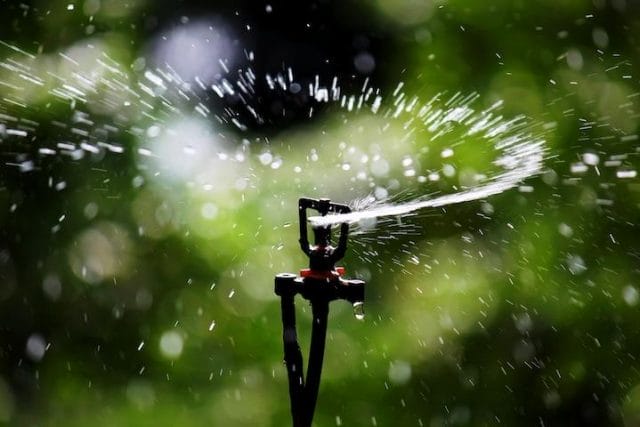This post is an adapted excerpt from the blog of Lawn Love, a Priceonomics customer
In January 2015, California Governor Jerry Brown declared a state of emergency due to California’s record-setting drought, requiring 25% in water savings across the state. Landscaping is the second largest component of water consumption in California at 9% of total use. Agriculture is by far the largest component at 77%. Replacing one’s lawn with an alternative or ceasing to water it is one of the highest impact activities that a regular person can do to save water.
But exactly how much water is saved when these switches are made? And what are the costs of the options? Generally, we found that if everyone in California got rid of their lawn, it would save 5-7% of total water usage in the state.
However, if you get rid of your lawn, you typically replace it with something that has a financial cost. Because water is so cheap, the financial payback period of replacing your lawn with a more drought tolerant substitute is around 30 years. The cost of water is so cheap that there is little incentive to reduce use.
***
The future of the lawn is a controversial topic. Critics see lawns as extravagances that provide little value, and an obvious culprit of water overuse. Lawn reformists are generally proponents of converting yards over to less resource intensive alternatives like drought tolerant plants or native plants species.
Defenders of the lawn see it as unfairly under “Under Attack”, given that water use for lawns pales in comparison to its use for agriculture. Many lawn reform skeptics believe the lawn plays important roles culturally (recreation, beauty, etc.) and environmentally (oxygen, carbon sequestration, etc.). Rather than eliminate lawns, they would prefer to see conservation through improved watering techniques.

Americans consume water in a variety of manners: Showers, washing clothes, flushing toilets and, for many homeowners, watering lawns. The Water Utility of Sonoma reports that the average “three-person family in a single detached home uses about 150,000 gallons of water annually.” By far the most intensive use of water for this type of family is for the lawn. A breakdown of this usage is below. These estimates are similar to other breakdowns of residential water use across the country.
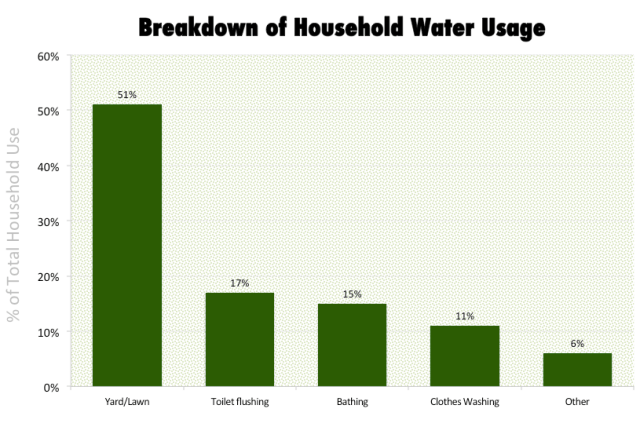
***
While there is a debate about how much emphasis should be put on conservation from lawns, even defenders of the lawn believe that there are a variety of ways water could be saved from residential landscaping. A report from the University of California Cooperative Extension argues that improved irrigation and plant care practices (such as fixing leaks, optimizing the time of day for irrigation, and cutting grass at a higher height) can lead to significant water reductions.
Beyond just changing watering practices, many conservationists are proponents of replacing conventional lawn grasses with less water thirsty alternatives. There are a variety of options for those looking to transform their lawn: Switching to “low maintenance, drought resistant grasses,” introducing plant species like shrubs and trees, using native plants, or even installing astroturf or xeriscaping, which can lead to little or no water usage at all.
We used research from the University of California’s Centre for Landscape and Urban Horticulture to estimate the gallons of water necessary in a given year for lawns with different types of plant species. These approximations are based on a 2,000 square foot lawn in the Sacramento Valley, and are probably on the low end of the average for a home in California. The formula used for these estimates can be found here. The estimates assume perfect distribution uniformity, which also may lead to underestimation.
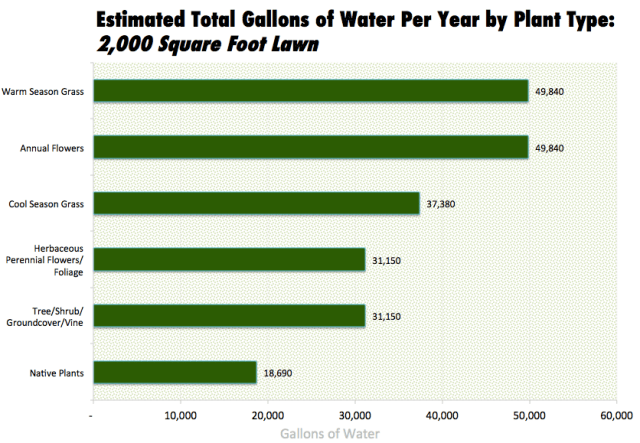
This data suggests a lawn of less water thirsty grass can save 25% of water use, and converting to native plants 60%.
For those that want to save the maximum amount of water and don’t want to have to deal with watering their yards, there are additional options. One popular choice is xeriscaping, which is creating a landscape that minimizes applied water use (there is not necessarily an emphasis on native plants). Although it varies across regions, we found estimates suggesting it would cost around $5.50 per square foot to xeriscape a yard in California. This would be $11,000 dollars for a 2,000 square foot yard.
Another popular option is laying down an artificial lawn. We found it would cost in the neighborhood of $10 per square foot to lay down artificial lawn in California, which would come out to $20,000 for a 2,000 square foot lawn. Some consumers are concerned about the health effects of artificial lawns, but the government continues to promote their use.
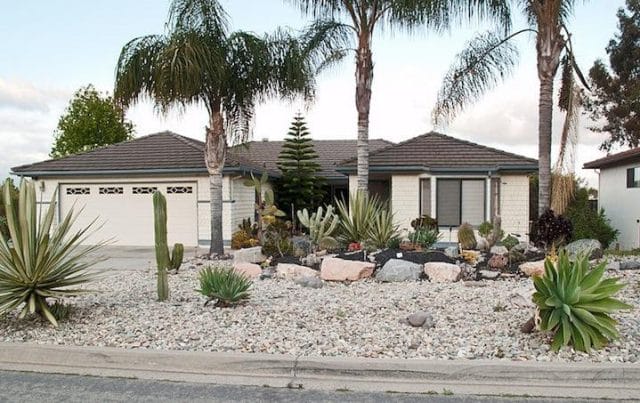
An example of a xeriscaped lawn.
Saving water also means saving on your water bill, but you have to be patient to see your investment repaid. Given that the costs to switch to a low water consumption option may be over $10,000, and watering the yard could only cost around $250 per year (at $.005 cents per gallon), it would take over 40 years for the investment to be repaid.
The Public Policy Institute of California studied the number of years it would take to recoup your investment from converting a lawn to a “water-efficient landscape” by region of California. Their estimates show that, for coastal Californians, it may take a lifetime for enough water savings to accrue to the point that the investment pays for itself. For those in the California desert, the savings are more substantial. In a best case scenario, the conversion might pay for itself within a decade. The following chart displays the estimated number of years it would take to recover your investment in different areas of California (based on a midpoint of the Public Policy Institute’s scenarios):
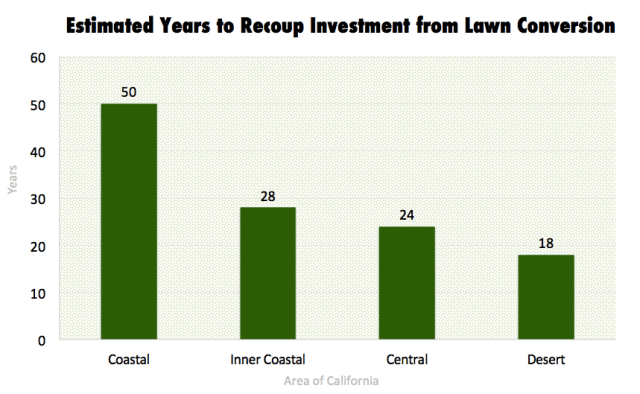
Based on these estimates, the average payback period is around 30 years for converting to a water-efficient landscape in California.
Given the long payoff of lawn conversion and the very immediate need to decrease water use, the California government has increased the incentive to convert to a low water use lawn. To entice people to convert their lawn, California and other states have introduced “cash-for-grass” subsidies that can add up to more than 5 dollars per square foot of lawn replaced with drought tolerant landscaping. The rebates are substantial enough that some companies will complete the conversion if the house owner hands over the rebate. The consumer gets the benefit of a lower water bill without having to pay for conversion, but one report suggests homeowners have had mixed reactions to losing their green garden.
***
The expectation that a homeowner should keep a pristine, green lawn is a relatively recent idea, but it is deeply entrenched in our society. At least in California, the recent drought has challenged that expectation, and has forced Californians to think about the ways in which lawns might be changed to reduce water use.
The immutable problem, however, is that the price of water is very cheap because everyone literally needs access to water. And while cheap water makes it accessible, it also results in very strong incentives to waste water and very few incentives to spend money to reduce water usage.
For our next post, we delve into the economics of professional pumpkin carving. To get notified when we post it → join our email list.




